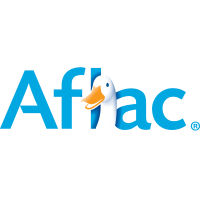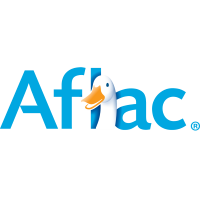
Aflac Inc
NYSE:AFL

Earnings Call Analysis
 Q4-2023 Analysis
Aflac Inc
Q4-2023 Analysis
Aflac Inc
Aflac Incorporated revealed a complex financial landscape in its fourth quarter 2023 results, with nuanced performances across its divisions and a solid capital base. Adjusted earnings per diluted share saw a 4.6% drop year-over-year, coming in at $1.25, affected by factors including currency exchange fluctuations and below-expectation variable investment income. Yet, the adjusted book value per share rose by 8.3%, indicating an expansion in the company's intrinsic value.
The company’s Japan operations faced some headwinds, with net earned premium falling by 8.5% due to effects like policy pay-ups and reinsurance transactions. After accounting for these factors, the core premium decline stood at a more moderate 1.7%. The Japan segment's total benefit ratio improved to 66.1%, a reduction from the previous year, reflecting well-priced legacy insurance blocks and solid underwriting performance. Persistence dipped slightly but remained robust. Japan's adjusted net investment income rose by 13.5%, benefiting from higher yields on U.S. investments and a strong alternate investment portfolio. This culminated in an impressive pretax margin of 30.4%, up significantly year-over-year.
In contrast, the U.S. operations painted a growth-oriented picture with a 1.1% increase in net earned premium and a surge in persistency to 78.6%, a sign of customer retention strength. Despite a slight year-over-year increase in the total benefit ratio, it remained lower than expected at 44.6%. Expense ratio rose, driven by strategic growth investments in sectors such as group life, network dental and vision, and direct-to-consumer channels, which are expected to scale and become more profitable. The U.S. segment’s pretax margin stood at a solid 18.4%.
Aflac disclosed some strain within its commercial real estate, with $1.2 billion on the watch list and $500 million in active foreclosure. Nevertheless, the company's conservative approach is evident in the increased reserves and the belief in the intrinsic value of its portfolio. Aflac's capital ratios remain robust, with an SMR above 1,100% and an RBC ratio anticipated to exceed 650%, showcasing a well-capitalized status ready to face potential market volatilities.
The Corporate segment recorded a pretax loss driven mainly by a loss from a reinsurance recapture. However, the negative impact was offset by the positive outcomes of higher rates, hedge income, and tax credit investments. Aflac ended the quarter with a strong liquidity position and a conservative leverage ratio below its targeted corridor. It continues to prudently manage its balance sheet and has shown confidence in its valuation through aggressive share repurchases and dividend payments.
Investors are directed to the 2024 outlook provided in the company's 8-K, which details the financial performance in 2023 and the expected drivers for the coming year’s earnings. This forward-looking view will be further elaborated in the upcoming earnings call, offering more clarity on Aflac's strategy and financial expectations.















 You don't have any saved screeners yet
You don't have any saved screeners yet




Thank you for joining me as I provide a financial update of Aflac Incorporated's results for the fourth quarter of 2023.
For the quarter, adjusted earnings per diluted share decreased 4.6% year-over-year to $1.25 with a $0.02 negative impact from FX in the quarter. In this quarter, remeasurement gains totaled $71 million and variable investment income ran $27 million or $0.04 per share below our long-term return expectations. We also entered into a reinsurance transaction that for U.S. GAAP purposes was treated as a recapture and led to a noneconomic loss of $151 million pretax. This transaction has very favorable economics to Aflac with returns significantly above our cost of capital. Adjusted book value per share, including foreign currency translation gains and losses, increased 8.3%, and the adjusted ROE was 10.5%, an acceptable spread to our cost of capital. Overall, we view these results in the quarter as solid.
Starting with our Japan segment. Net earned premium for the quarter declined 8.5%, reflecting the impacts of paid-up policies, reinsurance transactions and deferred profit liability. Lapses were somewhat elevated, but within our expectations. However, if adjusting for all these factors, the earned premium declined an estimated 1.7%. Japan's total benefit ratio came in at 66.1% for the quarter, down 90 basis points year-over-year. And the third sector benefit ratio was 56.2%, down approximately 150 basis points year-over-year. We continue to experience favorable actual to expected on our well-priced large and mature in-force block. We estimate the impact from remeasurement gains to be 130 basis points favorable to the benefit ratio in Q4.
Long-term experience trends as it relates to treatment of cancer and hospitalization continue to be in place, leading to continued favorable underwriting experience. Persistency remained solid with a rate of 93.4% and was down 70 basis points year-over-year. We tend to experience some elevation in lapses as customers update and refresh their coverage. This change in persistency is not out of line with expectations. Our expense ratio in Japan was 21.1%, down 40 basis points year-over-year, driven primarily by good expense control and to some extent, by expense allowance from reinsurance transactions.
Adjusted net investment income in yen terms was up 13.5% as we experienced higher yields on our U.S. dollar-denominated investments and related favorable FX. And a return on our alternative portfolio higher than last year's quarter. This was offset by a transfer of assets due to reinsurance. The pretax margin for Japan in the quarter was 30.4%, up 370 basis points year-over-year, a very good result. Turning to U.S. results. Net earned premium was up 1.1%. Persistency increased 130 basis points year-over-year to 78.6%. This is a function of poor persistency quarters falling out of the metric and stabilization across numerous product categories. Our total benefit ratio came in lower than expected at 44.6% but 40 basis points higher than Q4 2022. We estimate the remeasurement gains impacted the benefit ratio by 290 basis points in the quarter. Claims utilization has stabilized. But as we incorporate more recent experience into our reserve models, we have released some reserves.
Our expense ratio in the U.S. was 43.4%, up 230 basis points year-over-year, primarily driven by seasonality and higher DAC amortization. Our growth initiatives, group life and disability, network dental and vision and direct-to-consumer increased our total expense ratio by 420 basis points. We would expect this impact to decrease in 2024 and these businesses to grow to scale and improve their profitability. Adjusted net investment income in the U.S. was up 9.9%, mainly driven by higher yields on both our fixed and floating rate portfolios. Profitability in the U.S. segment was solid with a pretax margin of 18.4%, driven primarily by the remeasurement gains and partially offset by higher expenses.
Our total commercial real estate watch list remains approximately $1.2 billion, with around $500 million of these in active foreclosure proceedings. As a result of these current low valuation marks, we increased our CECL reserves associated with these loans by $26 million this quarter. We also moved 3 properties into real estate owned, which resulted in a $14 million write-down. We do not believe that the current distressed market reflects the true intrinsic economic value of our portfolio, which is why we are confident in our ability to take ownership of these quality assets, manage them through this cycle and maximize our recoveries.
In our Corporate segment, we recorded a pretax loss of $318 million, which is somewhat larger than a year ago, primarily driven by $151 million loss on the recapture of ceded reinsurance. While we saw the positive impact of both higher rates and amortized hedge income, adjusted net investment income was $116 million lower than last year due to an increased volume of tax credit investments. These tax credit investments impacted the corporate net investment income line for U.S. GAAP purposes negatively by $174 million, with an associated credit to the tax line. The net impact to our bottom line was a positive $23 million in the quarter. To date, these investments are performing well and in line with expectations. We are continuing to build out our reinsurance platform, and I am pleased with the outcome and performance.
In Q4, we executed another tranche with similar structure and economics to our first transaction from January 2023. Our capital position remains strong, and we ended the quarter with an SMR above 1,100% in Japan. In our combined RBC, while not finalized, we estimate to be greater than 650%. Unencumbered holding company liquidity stood at $2.8 billion, $1 billion above our minimum balance. These are strong capital ratios, which we actively monitor, stress and manage to withstand credit cycles as well as external shocks.
U.S. statutory impairments were $8 million, and Japan FSA impairment, JPY 1.5 billion or roughly $11 million in Q4. This is well within our expectations and with limited impact to both earnings and capital. Leverage remains at a comfortable 19.7%, just below our leverage corridor of 20% to 25% as we hold approximately 2/3 of our debt denominated in yen, our leverage will fluctuate with movements in the yen-dollar rate. This is internal and part of our enterprise hedging program protecting the economic value of Aflac Japan in U.S. dollar terms. We repurchased $700 million of our own stock and paid dividends of $245 million in Q4, offering good relative IRR on these capital deployments. We will continue to be flexible and tactical in how we manage the balance sheet and deploy capital in order to drive strong risk adjusted ROE with a meaningful spread to our cost of capital.
Before I end, I'd like to bring your attention to the 2024 outlook slides that we have included in our 8-K for fourth quarter earnings. On our earnings call tomorrow, we will address our financial results in 2023 as well as the drivers for earnings in 2024. I look forward to discussing our results in further detail on tomorrow's earnings call. Thank you for your attention.